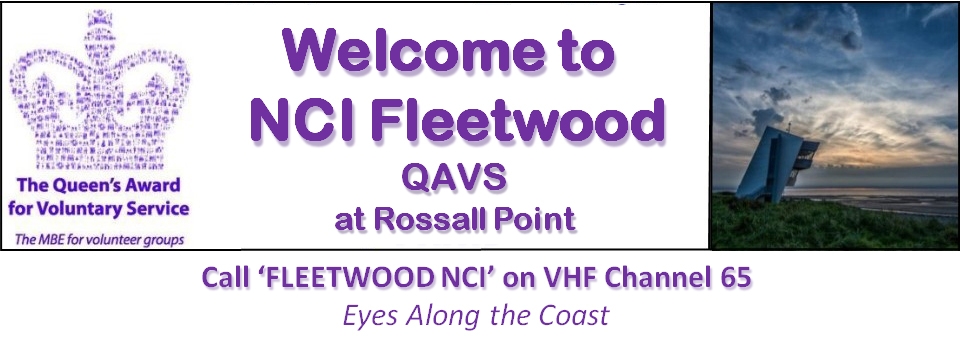Aids To Navigation
 This light shines with an unblinking and steady intensity and is always on. In this example a yellow fixed light is shown.
This light shines with an unblinking and steady intensity and is always on. In this example a yellow fixed light is shown.Group Flashing Gp Fl(x+x):
![]() This is actually a combination of two pat terns in one period.In this example the first two flashes followed by the pattern of 3 flashes result in: Gp Fl(2+3)
This is actually a combination of two pat terns in one period.In this example the first two flashes followed by the pattern of 3 flashes result in: Gp Fl(2+3)
Occulting Occ:
![]() Occulting is the opposite of flashing, the light is more on than off.
Occulting is the opposite of flashing, the light is more on than off.
Alternating AL:
![]() An alternating light changes colour. This special purpose light is typically used for special applications requiring the exercise of great caution. In this example ALT.WG is show, alternating between green and white.
An alternating light changes colour. This special purpose light is typically used for special applications requiring the exercise of great caution. In this example ALT.WG is show, alternating between green and white.
Morse Mo (U):
![]() This light shows two flashes and a long flash, Which is equivalent to the letter “U” in morse code.
This light shows two flashes and a long flash, Which is equivalent to the letter “U” in morse code.
Long Flashing LF l:
![]() This light has one long flash in a period, A long flash is a least 2 seconds long.
This light has one long flash in a period, A long flash is a least 2 seconds long.
Let’s look at some examples using colour, Period and phase characteristics. The arrows mark the periods:
![]() Fl (4) 8s
Fl (4) 8s
![]() Oc (2+3)1
Oc (2+3)1
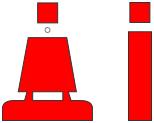
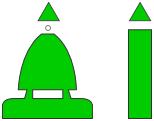
 Genarally, when two channels meet, one will be designated the prefared channel (ie. most important channel). The buoy depicted on the right indicates the preferred channel to starboard under IALA A. The light phase characteristic is R FL (2+1).
Genarally, when two channels meet, one will be designated the prefared channel (ie. most important channel). The buoy depicted on the right indicates the preferred channel to starboard under IALA A. The light phase characteristic is R FL (2+1).
 The buoy depicted above indicates the preferred channel to port under the IALA A, These buoys are marked with the names and numbers of both channels. The light phase characteristic is G FL (2+1):
The buoy depicted above indicates the preferred channel to port under the IALA A, These buoys are marked with the names and numbers of both channels. The light phase characteristic is G FL (2+1):
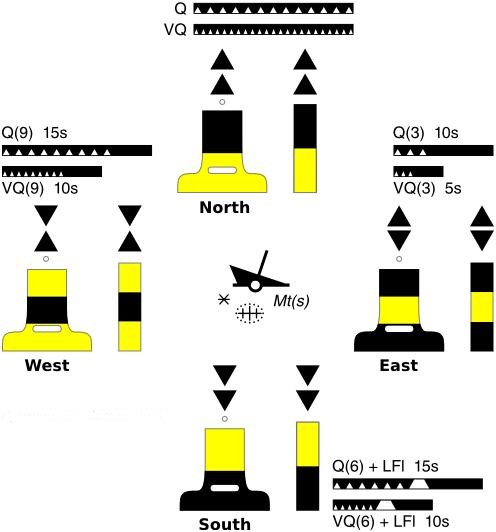
Marks Indicating Isolated Dangers
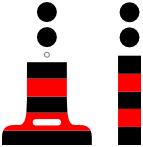 This type of buoy indicates the position of an isolated danger, contrary to cardinal buoys which indicate a direction away from danger. Body: black with red horizontal band(s); Topmark: 2 black spheres. The light (when present) consists of a white flash: Fl(2)
This type of buoy indicates the position of an isolated danger, contrary to cardinal buoys which indicate a direction away from danger. Body: black with red horizontal band(s); Topmark: 2 black spheres. The light (when present) consists of a white flash: Fl(2)Marks Indicating Safe Water
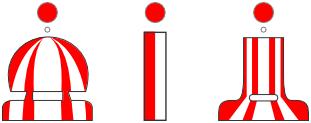 Notice that whereas most horizontal striping spells “danger”, this safe water buoy is vertically striped. These marks are for example seaward of all other buoys (lateral and cardinal) and can be used to make landfall. Body: red and white vertical stripes; Topmark (if any): single red sphere. Lights are typically calm and white: Morse A, Iso, Occ or LFl 10s.
Notice that whereas most horizontal striping spells “danger”, this safe water buoy is vertically striped. These marks are for example seaward of all other buoys (lateral and cardinal) and can be used to make landfall. Body: red and white vertical stripes; Topmark (if any): single red sphere. Lights are typically calm and white: Morse A, Iso, Occ or LFl 10s.
Marks For New Wrecks
After the sinking of the “Tricolor” in the Pas de Calais (Dover Straits) in 2002, several other vessels hit the wreck despite standard radio warnings, three guard ships and a lighted buoy. This incident spawned a new type of buoy, the emegency wreck marking buoy, which is placed as close as possible to a new dangerous wreck.
 The emergency wreck marking buoy will remain in position until: a) the wreck is well known and has been promulgated in nautical publications; b) the wreck has been fully surveyed and exact details such as position and least depth above the wreck are known; and c) a permanent form of marking of the wreck has been carried out.
The emergency wreck marking buoy will remain in position until: a) the wreck is well known and has been promulgated in nautical publications; b) the wreck has been fully surveyed and exact details such as position and least depth above the wreck are known; and c) a permanent form of marking of the wreck has been carried out.
I have saved these buoys for last since they lack an actual navigational goal. Most of the time these yellow buoys indicate pipelines or areas used for special purposes. I have drawn the five official IALA shapes,from left to right conical, spar, cylindrical, pillar and spherical.
Chart Symbols
The seafaring nations of the world – members of the International Hydrographic Organization – agreed in 1982 on an universal set of chart symbols, abbreviations, colours ect to be used in the nautical chart, in order to obtain uniformity.
On regular charts a white, red, yellow or green light will be indicated by![]() , and on GPS displays and modern multicoloured charts in specific colours :
, and on GPS displays and modern multicoloured charts in specific colours :![]() , with the yellow coloured lobe indicating a white light. The precise position of a chart symbol is its centre, or is indicated with a line and circle , the position circle.
, with the yellow coloured lobe indicating a white light. The precise position of a chart symbol is its centre, or is indicated with a line and circle , the position circle.
Two Distinct Types Of Sea Mark Are Drawn Differently In The Chart:
Beacons – fixed to the seabed; drawn upright;
Buoys – consisting of a floating object that is usualy anchored to a specific location on the sea floor; drawn at an oblique angle and with oblique numbering, decriptions of colours and light charactistics.
![]() Major floating light (light – vessel, major-light float, LANBY)
Major floating light (light – vessel, major-light float, LANBY)
![]() Light-vessel
Light-vessel
![]() Major light; Minor light
Major light; Minor light
![]() Green or black buoys (symbols filled black): G= Green; B= Black
Green or black buoys (symbols filled black): G= Green; B= Black
![]() Green or black beacon (symbol filled black). Note the upright G, instead of an oblique G
Green or black beacon (symbol filled black). Note the upright G, instead of an oblique G
![]() Single coloured buoys other than green and black: Y = Yellow ; R = Red
Single coloured buoys other than green and black: Y = Yellow ; R = Red
![]() Coloured beacon other than green and black, the symbol is again filled black so only the shape of the topmark is of navigational significance.
Coloured beacon other than green and black, the symbol is again filled black so only the shape of the topmark is of navigational significance.
 Multiple colours in horizontal bands, the colour sequence is from top to bottom
Multiple colours in horizontal bands, the colour sequence is from top to bottom
 Multiple colours in vertical or diagonal stripes, the darker colour is given first. W = White
Multiple colours in vertical or diagonal stripes, the darker colour is given first. W = White
![]() Spar buoy ( here a safe water mark)
Spar buoy ( here a safe water mark)
![]() Lighted marks on multicoloured charts, GPS displays and chart plotters.
Lighted marks on multicoloured charts, GPS displays and chart plotters.
![]() Lighted red beacon on standard charts.
Lighted red beacon on standard charts.
 Red beacon and green buoy with topmark, colour, radar reflector and designation. Red buoys and marks are given even numbers, green buoys and marks are given odd numbers.
Red beacon and green buoy with topmark, colour, radar reflector and designation. Red buoys and marks are given even numbers, green buoys and marks are given odd numbers.
 Wave – actuated bell buoy to the left, and to the right a Light buoy, with a horn giving a single blast every 15 seconds, in conjunction with a wave-actuated whistle. Other sounds include “Gong”, “Siren”, “Diaphone (Dia). The fog signal symbol may be omitted when a description of the signal is given.
Wave – actuated bell buoy to the left, and to the right a Light buoy, with a horn giving a single blast every 15 seconds, in conjunction with a wave-actuated whistle. Other sounds include “Gong”, “Siren”, “Diaphone (Dia). The fog signal symbol may be omitted when a description of the signal is given.
![]() Leading Beacons – Leading line (firm line is the track to be followed)
Leading Beacons – Leading line (firm line is the track to be followed)
Leading Lights
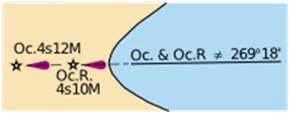
# : any two objects in line under each other). Bearing given in degrees and minutes. The lights are synchronized. The red light has a shorter nominal range ( the distance from which the light can be seen) : 10 nautical miles.
 All- round light with obscured sector.
All- round light with obscured sector.
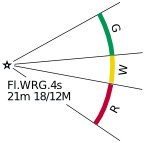 Sector light on mulicoloured charts. The elevation is 21 meters ( height of the light structure above chart datum). The nominal range of the white light is 18 nautical miles. The range of the green and red lights is 12 nautical miles.
Sector light on mulicoloured charts. The elevation is 21 meters ( height of the light structure above chart datum). The nominal range of the white light is 18 nautical miles. The range of the green and red lights is 12 nautical miles.
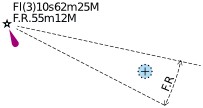 Main light visible all-round with red subsidiary light seen over danger. The fixed red light has an elevation of 55 metres and a nominal range of 12 nautical miles. The flashing light is white, with 3 flashes in a period of 10 seconds. The elevation is higher than the red light: 62 metres and the range of the white light is 25 nautical miles.
Main light visible all-round with red subsidiary light seen over danger. The fixed red light has an elevation of 55 metres and a nominal range of 12 nautical miles. The flashing light is white, with 3 flashes in a period of 10 seconds. The elevation is higher than the red light: 62 metres and the range of the white light is 25 nautical miles.
![]() Symbol showing direction of buoyage (where not obvious).
Symbol showing direction of buoyage (where not obvious).
![]() Symbol showing direction of buoyage (where not obvious), on multi-coloured charts (red and green circles coloured as appropriate), here IALA A
Symbol showing direction of buoyage (where not obvious), on multi-coloured charts (red and green circles coloured as appropriate), here IALA A
Full Example Of A Light Description In The Chart
Fl (3)WRG.15s21m15-11m
Class Of Light: group flashing repeating a group of three flashes;
Colours: white, red, green, exibiting the different colours in defined sectors;
Period: the time taken to exhibit one full sequence of 3 flashes and eclipses: 21 metres;
Nominal Range(s): white 15m, green 11m; red between 15 and 11m where “M” stands for nautical miles.
Lateral Marks- direction of buoyage
Lateral marks are generally for well- definded channels and there are two international Buoyage Regions – A and B – where these lateral marks differ. Where in force, the IALA System applies to all fixed and floating marks exept landfall marks, leading lights and marks, sectored lights and major floating lights.
The standard buoy shapes are cylindrical (can)![]() , conical
, conical![]() , spherical
, spherical![]() , pillar
, pillar![]() and spar
and spar![]() , but variations may occur, for example: minor light- floats . In the illustrations below, only the standard buoy shapes are used. In the case of fixed beacons – lit or unlit- only the shape of the topmark is of navigational significance.
, but variations may occur, for example: minor light- floats . In the illustrations below, only the standard buoy shapes are used. In the case of fixed beacons – lit or unlit- only the shape of the topmark is of navigational significance.
IALA Region A: Europe, Africa, New Zeland, Australia, China, India, Russia, Indonesia,Turkey, Middle East ect.
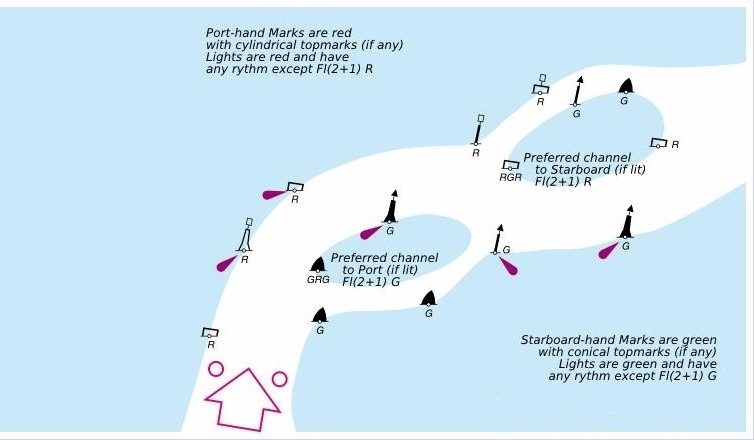
IALA Region B: Americas, Japan and Korea.
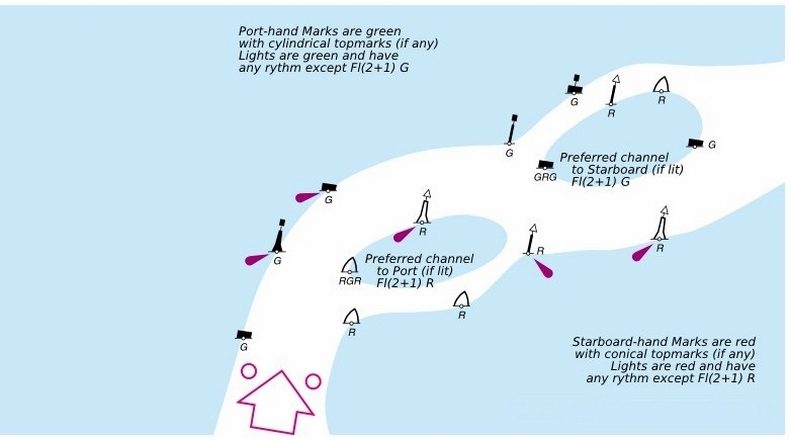
Visibility Of Lights
It is important to know at what distance we may(begin to) see a certain light, and when we can expect to lose sight of it, especially when making landfall. Several practical ranges are used to describe the visibility of lights in navigation:
The Meteorological Range is based on the current atmospheric conditions. The table below shows that the atmosphere immensely influences the visibility of light travelling through it.
Meteorological Optical Range Table
Code Weather Distance(m) Code Weather Distance (nautical miles)
0 Dense Fog Less than 50 metres 5 Haze 1.0 – 2.0
1 Thick Fog 50 – 200 6 Light Haze 2.0 – 5.5
2 Moderate 200 – 500 7 Clear 5.5 – 11.0
3 Light Fog 500 – 1000 8 Very Clear 11.0 – 27
4 Thin Fog 1000 – 2000 9 Exeptionally Clear Over 27.0
The Geographic Range is based on the elevation of the light. A higher light means that its horizon is farther away, see distance of horizon. Morever, if the observer’s height of eye is higher than sea level the light can be seen beyond its geographic range, the dipping range. However on sailing yachts this potential is limited.
The Nominal Range of a light is based on its candlepower, and is typically the range mentioned in the chart. The nominal range is the maximum distance at which a light can be seen in weather conditions where visibility is 10nm.
So, a minor light – perched on a 70m high cliff – with a geographic range of 20nm will not be detectable by the human eye at a distance of 6nm.
1. if the nominal range is just 5nm.
2. if the meteorological range is just 5nm due to light haze.
Because of the limiting factor of the geographic range, most major lights will never be seen from a sailing yacht 20nm miles away. yet, it is sometimes possible to take a bearing on the loom of the light: its reflection against the clouds.
Differtent coloured lights with equal candlepower have different ranges. White light is the most visible followed by yellow, green and then red. herefore, at extreme ranges an “AL WG” can resemble a “Fl W”.
The range of a lit buoy is never indicated – with the exeption of a LANBY – but on a clear night the maximum range is 3 nm, yet often considerably less. There are 2 visual clues to determin your distance from a buoy: at about 0.5 nm, the light will rise up from the horizon, and about 200nm, the light will reflect in the surface.
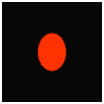
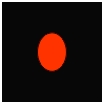
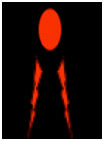
Buoy at less Buoy at less Buoy at less
than 3nm than 0.5 nm than 200nm
Glossary
Navigation Aid: An onboard instrument, device, chart, method, ect., intended to assist in the navigation.
Aid To Navigation: A device or structure external to the ship, designed to assistin determination of position, to define a safe course, or to warn of dangers or obstructions.
Mark, Seamark, Navigation Mark: An object or artificial or natural object of easily recognizable shape or colour, or both, situated in such a position that it may be identified on a chart. A fixed artificial navigation mark is often called a Beacon.
Light Characteristics: The sequence and length of light and dark periods and the colour or colours by which a navigational light is identified.
Topmark: One of more objects of characteristic shape placed on top of a buoy or beacon to aid in its identification.
Latereral Mark: An aid to navigation intended to mark the sides of a channel or waterway.
Cardinal Marks: An IALA aid to navigation intended to show the location of a danger to navigation based on its position relitive to the danger using the “cardinal point”: north, east, south, west.
Isolated Danger Marks: An IALA aid to navigation marking a danger with clear water all around it; it has a double ball topmark and is black with at least one red band. If lighted its characteristic is Fl(2).
Sector Light: A light having sectors of different colours or the same colour in specific sectors separated by dark sectors.
Light Sector: As defined by bearings from seaward, the sector in which a navigatioal light is visible or in which it has a distinctive colour difference from that of adjoining sectors, or in which it is obscured.
Light House: A distinctive structure exhibiting a major navigational light.
Light List: A publication giving detailed imformation regarding lighted navigational aids and fog signals.
Landfall: The first sighting (even by radar ) of land when approached from seaward.
Range: Two or more objects in line. such objects are said to be in range. An observer having then in range is said to be on the range. Two beacons are frequently located for the secific purpose of forming a range to indicate a safe route or the centreline of a channel.
Leading Line: On nautical chart, a straight line, drawn through leading marks. A ship moving along such line will clear certain dangers or remain in the best channel.
Range Lights: Leading Lights; Two or more lights at different elevations so situated to form a range (leading line) when brought into transit. The one nearest to the observer is the from light and the one farthest is the rear light. The front light is at a lower elevation than the rear light.
Lights in Line: Two or more lights so situated that when observed in transit they define a position: the limit of an area, an alignment used for anchoring, ect. Not to be confused with range lights, which mark a direction to be followed.
Light Float: A buoy having a boat – shaped body. Light floats are nearly always unmanned and are used instead of smaller lighted buoys in waters where strong currents are experienced.
Primary (sea coast) Light: A light established for purpose of making landfall or coastwise past from headland to headland.
Secondary Light: A major light, other than a primary (sea coast) light, established at harbour entrances and other locations where hight insensity and reliability are required.
Major Light: A light of high intensity and reliability exibited fron a fixed structure (lighthouse) or on marine site (exept rangelights). Major lights include primary sea-coast and secondary lights.
Minor Light: an automatic unmanned light on a fixed structure usually showing low to moderate intensity. Minor lights are established in harbours, along channels, along rivers, and in isolated dangers.
Visual Range: The extreme distance at which an object of light can be seen.
Geographic Range: The extreme distance limited by the curvature of the earth and both the heights of the object and the observer.
Bobbing A Light: Quickly lowering the height of eye and raising it again when a navigational light is first sighted to determine if the observer is at the geographic range of the light.
Luminous Range: The extreme distance limited only by the intensity of the light, clearness of the atmosphere and the sensitiveness of the observers eye.
Luminous Range Diagram: A diagram used to convert the nominal range of a light to its luminous ranfe under existing contitions.
Charted Or Nominal Range: The nominal range is indicated in the chart next to the light or can be found in the Light List. This is the maximum distance at which the light may be seen at night based upon intensity and 10 nautical miles of visibility.
Meteorological Range: The nominal range is indicated in the chart next to the light or can be found in the Light List. This is the maximum distance at which the light may be seen at night based upon intensity and 10 nautical miles of visibility.
Helping to Save Lives
